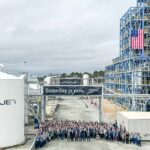The Australian government has prioritised decarbonisation of air transport in its newly-released Aviation Green Paper, ‘Towards 2050’ (AGP50), which lays the foundations for the nation’s aviation policy over the next decades. The document identifies key issues and calls for industry and public submissions to help shape a long-term strategy, which will be unveiled next year in the government’s Aviation White Paper. AGP50 highlights the importance of sustainable aviation fuel and both electric and hydrogen propulsion technologies in reducing emissions from aircraft operations, while expecting all emitters in the aviation industry – not just airlines – to contribute to net zero commitments. Meanwhile, the nation’s largest airline company, the Qantas Group, has said it will increase its SAF commitments to as much as 500 million litres per year from 2028, in partnership with aircraft manufacturers Airbus and Boeing, from which it has just placed firm orders for 24 new widebody jets.
The Aviation Green Paper was launched by Catherine King, the national Minister for Infrastructure, Transport, Regional Development and Local Government. The focus on decarbonising Australia’s air transport forms part of the government’s broader 2030 programme to reduce carbon emissions by 43% below 2005 levels, enroute to its target of net zero emissions by 2050. “The Covid-19 pandemic resulted in the largest shock the aviation industry has ever experienced,” said King. “The next challenge is decarbonisation.”
The Green Paper identifies four key pathways to decarbonise flight operations – primarily SAF, followed by fleet renewal, electric and hydrogen aircraft propulsion and air traffic management. Airports and other areas of the aviation industry, including airport service providers such as catering, security, safety, refuelling and aircraft support and maintenance, are all expected to rise to the net zero challenge.
According to the 224-page document, Australia could develop a diversified portfolio of locally-produced feedstocks to help establish a domestic SAF industry, but acknowledges large volumes were instead being exported to SAF producers in other countries, and that Australia’s lack of refining capacity reduced opportunities to develop renewable fuel.
However, it adds: “Large landmass, temperate climates, advanced farming practices and established land transport supply chains are potential assets to develop a range of biogenic feedstocks. These comparative advantages can be seen in Australia’s current production and export volumes in oilseeds, sugars and agricultural residues.
“A situation where Australian-produced feedstock is exported internationally under long-term supply contracts could undermine feedstock use by Australian refiners and operators, and result in Australia missing out on the economic and sustainability benefits of domestic SAF production.”
Hydrogen propulsion is promising though “unlikely to enter widespread deployment until earliest 2035, with 2040-2050 more likely,” observes AGP50, while electric propulsion is expected for low-capacity, short-range flights by the early 2030s.
“Using new fuel such as hydrogen for longer-haul flights would face significant technological and supply chain challenges, such as developing onboard hydrogen storage and establishing large-scale green hydrogen production and distribution. Creating refuelling and recharging infrastructure and large-scale manufacturing capabilities will require time and investment, and costs are currently unclear.”
The Green Paper acknowledges the role of high-quality offsets as a means of achieving net emission reductions “rather than a measure to decarbonise aviation,” and notes demand had grown with net zero targets. It added: “Offsets will play a role in the near term as other technologies scale and in the long term to address residual CO2 emissions. However, social impact challenges remain about quality and transparency of offsets and reliability of accounting data.”
Under reforms to emissions safeguard mechanisms in Australia, emissions limits, or baselines, for Australia’s largest-emitting airlines will reduce by 4.9% per year, says the white paper, “creating demand for abatement options such as SAF, fleet renewal and the use of high-quality offsets.”
As well, because facilities which used carbon offsets equal to 30% or more of their baseline would need to detail why they were not delivering more actual emissions abatement, “this may drive increased uptake of SAF and other decarbonisation measures where available.”
Shifts to alternative transportation modes such as high-speed rail could dampen demand for flights, suggests the government, as might more use of technologies such as videoconferencing. “However, while these options exist in Australia, the country’s relatively lower connectivity, dispersed population and geographical isolation from the rest of the world may limit flight alternatives.”
The Aviation Green Paper was released soon after Qantas announced a large increase in its proposed uptake of SAF, in partnership with airframers Airbus and Boeing, as part of new orders for widebody jets. In addition to significant recent orders for narrowbody Airbus A220 and A320-family aircraft, and widebody Boeing 787-9 Dreamliners, Qantas has ordered 12 more long range Airbus A350s and 12 more Boeings, a mix of 787-9s and larger 787-10s, to replace current A330s from 2027 and A380s from 2032.
The deals include access to up to 500 million litres of SAF each year from 2028, including the airline group’s current commitments for 80 million litres. This accounts for 90% of the company’s interim target that SAF should comprise 10% of its 2030 jet fuel consumption. The SAF would be sourced in the US, said Qantas, “at favourable prices due to favourable government polices” – a thinly-veiled reference to the current lack of government support for SAF development or incentives for use in Australia.
Photo: Qantas














More News & Features
LanzaJet produces first next generation, ethanol-based SAF at flagship Freedom Pines refinery
European Commission announces Sustainable Transport Investment Plan to advance low-and-no-carbon fuels
XCF plans three new Australian SAF plants, while Wagner and FlyOro activate blending facility
UK government starts new consultation on SAF revenue certainty mechanism
African Development Bank and Japanese industrialist unite to explore SAF production in Africa
LanzaJet and KMG agree to progress SAF production project in Kazakhstan